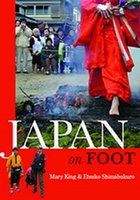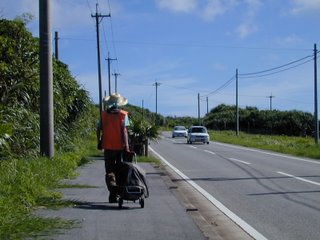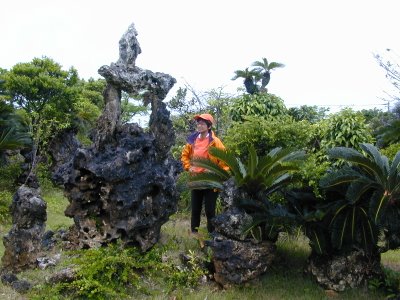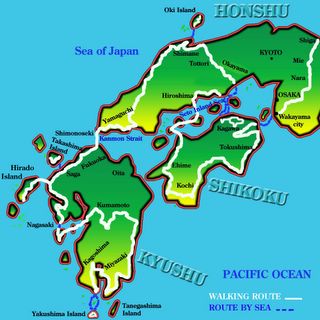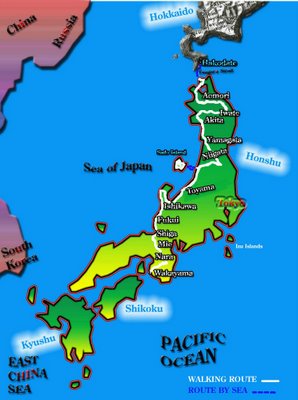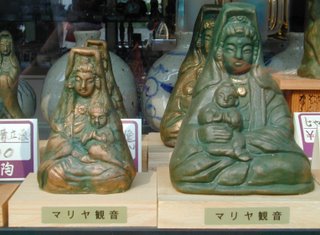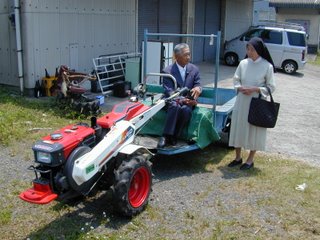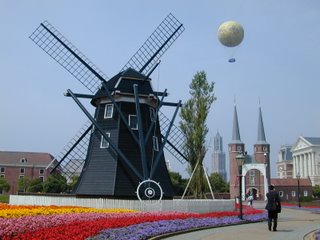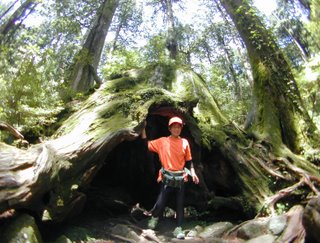SHIKOKU IS a walkers’ paradise, with most people coming here as pilgrims to follow the mandala-like circuit of the eighty-eight temples that are dedicated to the island’s famous son, Kobo Daishi. The ninth-century monk spent years wandering the mountains and forests of this island before reaching enlightenment in a cave on the island’s southeastern tip. Today, thousands of pilgrims follow in the footsteps of Kobo Daishi (a.k.a. Kukai), founder of the Shingon Buddhist sect, but how many people who visit the temples and shrines of Shikoku have heard that another great religious leader came here bearing the treasures of King Solomon, and that the Ark of the Covenant lies buried under a shrine in Tokushima prefecture? According to a former councilor of Kamiyama town, the Old Testament prophet Elijah came to Shikoku with members of an ancient Hebrew tribe, bearing the Ark of the Covenant, as well as such treasures as the Ten Commandments, Aaron’s rod and the gold pot of manna that is said to have provided sustenance to the Israelites during their forty years of walking through the Sinai. Kamiyama, or "Mountain of the Gods," is undoubtedly an idyllic place but could this be the original Garden of Eden? Mr. Takashi Chinaka believes that this is the land of Adam and Eve, as introduced in Genesis in the Bible. The Shingon Buddhist also maintains that Kamiyama is where Elijah, known locally as Inai, built a second Jerusalem and buried the treasures of the king who lived almost one thousand years prior to the birth of Christ. Etsuko and I had traipsed out to this remote part of Shikoku to hear more about what Mr. Chinaka maintains is the roots of the Japanese. The seventy-three-year-old is very serious about his subject and has penned two books on Solomon’s treasures and how the people of Kamiyama, including himself, are descendants of the Ebisu tribe that came to this area in ancient times bearing treasures that they "were instructed to take as far away from the Holy Land as possible." The Ark of the Covenant was the ultimate treasure in the Tabernacle, renowned for its mysterious powers against the enemies of Israel. "I’m certain that the Ark of the Covenant is buried under Kami-Ichinomiya shrine, and that the other treasures of King Solomon can be found in this area too. Once these treasures are found, peace will be restored to the world," Mr. Chinaka told us, explaining where we could find the shrine. So, who were the Ebisu people? I asked. Mr. Chinaka maintains that the Shinto god, Ebisu, who is linked to labor and the sea, is named after the ancient Hebrew tribe that came here from Jerusalem. Apparently, the "Ebisu-jin" and Inai built a second City of David in Kamiyama and later, Inai (Elijah) helped Emperor Jimmu build a third Jerusalem in Kashihara (present-day Nara prefecture). "Japan’s first Emperor had Jewish roots," Mr. Chinaka said, "and Shinto is derived from the polytheistic faith of ancient Hebrew tribes." "What you have to remember is that the ancient Hebrews worshiped many gods; not just the one that is prayed to today," he continued. "The gods of Shinto are the gods that the Ebisu people brought with them from Israel," added the man who espouses no Christian or Jewish beliefs. So, what do the people of Kamiyama think about all this? Certainly, we heard a few guffaws and groans in nearby shops and restaurants when we mentioned the subject but, on the other hand, local people also chipped in financially so that Mr. Chinaka could build a shrine dedicated to Inai (Elijah) on his land. Etsuko and I strolled up the mountain path to view the shrine at which Mr. Chinaka and other local people pray. A huge Star of David and the chrysanthemum crest of Japan’s imperial line mark the entrance to Inai’s shrine. Nearby stands a three-legged torii gate that, according to Mr. Chinaka, is a replica of the rocket launcher used by Elijah and the Ebisu people when they "flew from Jerusalem to Ethiopia."

ME TARZAN, YOU JANE
A RED double-decker bus appeared like a mirage out on the coastal road of Yoshi Umi town, Oshima island. Surrounded by tatty vegetable allotments and with a pyramid-shaped mountain towering over it, the old London Transport bus looked like it had gone into long and happy retirement. It turned out that the bus now serves as a karaoke bar-cum-coffee shop, and feeling pangs of nostalgia for these grand queens of London that some twenty years ago used to transport me from my flat on the Abbey Road to newspaper offices down by Hammersmith Bridge, I couldn’t resist hopping on board. "Otoko! Otoko! (Man! Man!)," a drunken fellow screamed in my face after I went upstairs to check out who was singing folk songs. "Seitenkan desu. (I’m a transsexual)," I blandly told the chap, having finally become immune during the course of this walk to Japanese inquiring about my gender. The middle-aged chap was stunned and then turned to Etsuko to yell at. "I don’t understand the foreigner; it’s some om-yomi (Chinese pronunciation) word. Is the gaijin a man or a woman?" he bellowed at my partner while thrusting a puny bicep under my nose. "Ore! Boku! Ore!" he shrieked, repeatedly stabbing his nose so that I could clearly see him as he used coarser words to inform me of his maleness. "Yes, you Tarzan," I laughed at his flabby muscle before turning on my heels and returning to the lower deck for coffee. The owner of the bus was a middle-aged woman with long, dyed-brown hair, who looked delightfully decadent wearing a Stetson while rustling up refreshments in the driver’s cabin-cum-kitchen of the old London bus. "It cost about four million yen to buy, transport to Japan from England, and then refurbish," the Cowgirl said proudly of her bus. "It’s a bit of an old banger but you can still take it for a spin," she explained. Tarzan came over to pester us more with questions on my gender. "Onna? Otoko?" he ranted at Etsuko, who waved him away like a pesky flea and told him to address me with his queries. "Japanese men are stupid," Cowgirl informed me in a matter-of-fact tone after I told Tarzan, yet again, that I am a transsexual. "Is the gaijin a virgin?" he screamed in Etsuko’s face. "I’m sorry," Cowgirl apologized and we tried to continue our conversation. Tarzan, however, was not going to be ignored and turned on Etsuko once more. "Don’t ever trust gaijin," he scolded her. "They are bad; they will drop the bomb on you like they did in Hiroshima," he blathered. "All gaijin are bad, especially when they don’t say what sex they are. So what about you—are you a foreigner too?" he spat. "Where are you from? What are you two up to?" he yelled. "I’m from Okinawa, and we’re both walking from Hokkaido to Yonaguni Island, the island where my grandmother is from, We’ve now walked more than five-thousand kilometres and like to take our rests in peace," Etsuko calmly replied. "So, you’re a gaijin too, then. I knew it," snarled Tarzan. "Okinawans aren’t real Japanese. You lot once had to have passports to come to Japan," he sneered. "And, you," he turned to me, waving a nicotine-stained finger under my nose, "are you a man or a woman?" "I’m a man, it’s obvious," I groaned, having wearied of this greasy-faced fellow breathing whisky all over me. He was clearly begging for a good biff around the earhole. Lurching forward, Tarzan took a lunge for my crotch and I pushed him away, clenching my fist ready to punch his lights out should he aim for my womanhood again. The bus owner scowled at him before apologizing and bowing profusely as Etsuko and I picked up our belongings to hit the road again. "I’m sorry," Cowgirl sighed, "Japanese men are just stupid; they’re very insecure. "Take good care on your walk," she laughed, saluting us off with a wave of her Stetson.
IN LATE March we left Kagawa prefecture, Shikoku, and returned to Japan's biggest island, Honshu. Almost a year has passed since we embarked on our journey from Hokkaido's northernmost point and as our pedometers approach the six thousand-kilometre mark, Etsuko and I are just relieved to have made it so far unscathed. We have trekked through typhoons, hailstorms and snow, and kipped down for the night in bus shelters, railway stations, on old steam trains and even slept among the dead. Dangers on the road have included bears, stray dogs, unpaved tunnels and reckless drivers. Etsuko is still in tip-top shape while I am a physical wreck. Shin splints from footslogging along hard asphalt and repetitive strain injury in my arms caused by dragging the luggage trolley have been giving me much grief and pain. However, we are both still determined to reach the shores of Yonaguni Island, from where we will dive out to what some claim is Asia's equivalent of Atlantis—the lost civilization of Mu. There are endless stories to tell as we have gleaned more insight into Japan and her people. For Etsuko, perhaps the biggest surprise has been discovering how so much of Japanese life is ruled by superstition and prejudice, and how most of the concepts Japanese uphold about themselves just don't always gel. For me, surprises have included realizing how little many Japanese know about their own history and culture, as well as their sometimes staggering ignorance of other nations too. Hailing from a country that once ruled much of the world, I'm still gobsmacked by Japanese who don't know what continent Britain is on or who can't grasp that the English speak English. "I don't believe it," squealed a middle-aged man in a restaurant out in the wilds of Shikoku. "Yes, they speak English like the Queen of England," the owner of the restaurant informed his friend. "The queen speaks English too?" the chap almost hit soprano in surprise. "She's recently died, hasn't she? I am so sorry," he bowed towards me. "The queen is very much alive and kicking," I explained, "She is marking her Golden Jubilee—fifty years on the throne—this year," I said, realizing he had confused Queen Elizabeth with her sister, Princess Margaret, who died earlier this year. "I thought only Americans spoke English," the chap gasped before wolfing down some sushi. The restaurant owner decided to give his friend a history lesson. "America is a penal colony of England; that's how come Americans speak English. "England sends all its criminals to America," he told his mate whose eyes were bulging wider by the minute. Etsuko quickly butted in to explain that America—like Australia—"was once" a British penal colony. "Ooh, is that so!" the chap exclaimed as he chomped on some pickled ginger. "So that's why America has so much crime and England doesn't have any police, eh?" Etsuko and I were completely baffled. "Only Scotland has police, right? They're called Scotland Yard," the chap continued. "It's a very odd name for a police force," he chuckled over his sake.
ANSWERING THE CALL OF KAGAWA
PHOTOS BY JAPAN ON FOOT
2001/2002
 The toilet museum, we were informed, was the brainchild of Unicharm, a company that makes baby diapers and women’s toiletries, and since opening in the early 1990s it has attracted a regular trot of visitors. "Tourists are tired of three-K toilets: kitanai, kurai and kusai (dirty, dark and deadly to the nose)," said Tokiharu Usami, a director of Gold Tower. "Unicharm aims to change the image of public lavatories for ever," he told us. Certainly, the Gold Toilet and matching slippers changed our view of Japan’s public loos, and undoubtedly they will live on as a testament of the excesses of Japan’s "bubble" years—when Japanese earned a reputation for throwing money down the toilet.
The toilet museum, we were informed, was the brainchild of Unicharm, a company that makes baby diapers and women’s toiletries, and since opening in the early 1990s it has attracted a regular trot of visitors. "Tourists are tired of three-K toilets: kitanai, kurai and kusai (dirty, dark and deadly to the nose)," said Tokiharu Usami, a director of Gold Tower. "Unicharm aims to change the image of public lavatories for ever," he told us. Certainly, the Gold Toilet and matching slippers changed our view of Japan’s public loos, and undoubtedly they will live on as a testament of the excesses of Japan’s "bubble" years—when Japanese earned a reputation for throwing money down the toilet. THE INKBLOT TEST
AN ELDERLY pilgrim had shown us the two white tunics that he has had stamped with the seals of temples during the course of his pilgrimage on foot around Shikoku's eighty-eight temples. "This is the second time I have walked the eighty-eight temples," the fellow explained to us in the grounds of Okubo-ji temple, which for most pilgrims is the final temple on the pilgrimage that is dedicated to the Buddhist saint, Kobo Daishi. "Tomorrow, I will walk back into Tokushima prefecture and revisit Ryozen-ji temple," he added, referring to what is usually the first temple visited by pilgrims and occasionally the one at which some pilgrims choose also to finish, thus completing a mandala-like circuit."The one tunic I will wear when I die and the other will lie in my arms when I'm buried," the old chap told us proudly as he handed over a tunic to be stamped by one of the monks at the eighty-eighth temple in Nagao town, Kanagawa prefecture. Etsuko pointed her camera, wanting to capture the momentous occasion for the man, who had mentioned to us that he was sad that he had so few pictures of himself during his pilgrimages. "Shitsurei! (It's rude)," the young monk barked at Etsuko as she focused on the pilgrim receiving his seal from an elderly monk. We all almost jumped out of our skin with fright. The young monk glared at us over his desk. "Shitsurei, ja nai (It's not rude)," I softly told the acolyte who had been busy writing calligraphy on some prayer plaques. "Subete wa gensou desu (Everything is illusion)," I told him, quoting one of my favourite Buddhist proverbs, which I like to pull out of my hat when dealing with people who describe me, or some particular situation, as being rude. The young monk's face turned purple with rage, his jaw muscles bunching, and I was terrified that his knuckles might be the next thing to bunch up and come flying towards me. The air felt like it had been sliced by a sword. The monk's calligraphy brush quivered slightly and a delicate tear of Indian ink fell, turning into a thick black blob on the end of one of his kanji strokes. The monk observed me like a cat ready to pounce on a bird. The whole world seemed to be holding its breath for an eternity, and I felt that the Ma--the pregnant silence--might just suffocate us all, but for what? A mere inkblot? But, the inkblot, I mused, could be viewed as a threat--it had the power to serve as a mirror reflecting the stain on the acolyte's mind. Or, perhaps the young monk might interpret the blot as his karma. If he chose to consider it as a visual koan, then the blot had the potential to remind him of the "Void"--the Mu--the nothingness of everything. I was totally confused by the blot and what I should do next. Guilt welled up inside of me and I felt a need to apologize and be forgiven, but I decided that it was, indeed, the inkblot that had been "Shitsurei" and not me or Etsuko. Fearing that the monk might spew forth the wrath of Fudo Myo (God of Fire) upon me, an urge to run overwhelmed. But, was there anything at all that I could possibly do or say to make the young monk feel slightly better--or, perhaps, even slightly worse? "Kobo mo fude no ayamari (even Kobo Daishi makes mistakes with his calligraphy brush)," I spouted from my mental stock of proverbs before bowing at the monk. He now looked as if he was on the verge of throwing an apoplectic fit. I hastily retreated through the gates of Okubo-ji, in the Realm of Entering Nirvana, with Etsuko and the old henro hot on my trail.






